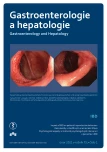A rare cause of the small bowel ulcers
Authors:
Leksa V.; Kubát J.; Vyhnálek P.
Authors‘ workplace:
Interní oddělení, Nemocnice Pardubického kraje a. s., Pardubická nemocnice
Published in:
Gastroent Hepatol 2021; 75(1): 55-60
Category:
Clinical and Experimental Gastroenterology: Case Report
doi:
https://doi.org/10.48095/ccgh202155
Overview
Zollinger-Ellison syndrome is a very rare disease characterized by increased production of gastric acid that leads to peptic ulcer disease and diarrhea. It is caused by disproportionate ectopic secretion of gastrin from the cells of the endocrine tumor of digestive system – gastrinoma. It occurs sporadically or as a part of multiple endocrine neoplasia type 1. The tumor is localized mostly in duodenum and pancreas. The treatment combines control of gastric acid secretion, nowadays mainly by proton pump inhibitors and the treatment of gastrinoma itself – surgical or oncological (chemotherapy, biological treatment). In our paper, we present a case of a middle-aged woman examined for abdominal pain and diarrhea. Her initial gastroscopy showed erosive duodenitis; we excluded the infectious etiology of the diarrhea. During the examination process, there were severe complications of peptic ulcer disease for which several surgeries were done. From all the laboratory results and imaging methods, the final diagnosis was made – Zollinger-Ellison syndrome due to gastrinoma of the tail of pancreas and the patient underwent surgery. Unfortunately, there was a progression of the disease in a short time that requested another oncological and surgical treatment.
Keywords:
Zollinger-Ellison syndrome – gastrin – gastrinoma – peptic ulcer – proton pump inhibitors – Somatostatin
Sources
1. Zollinger RM, Ellison EH. Primary peptic ulcerations of the jejunum associated with islet cell tumors of the pancreas. Ann Surg 1955; 142(4): 709–728.
2. Epelboym I, Mazeh H. Zollinger-Ellison syndrome: classical considerations and current controversies. Oncologist 2014; 19(1): 44–50. doi: 10.1634/ theoncologist.2013-0369.
3. Weber HC, Venzon DJ, Lin JT et al. Determinants of metastatic rate and survival in patients with Zollinger-Ellison syndrome: a prospective long-term study. Gastroenterology 1995; 108(6): 1637–1649. doi: 10.1016/ 0016-5085(95)90124-8.
4. Klimstra DS, Kloppell G, La Rosa S et al. Classification of neuroendocrine neoplasms of the digestive system. In: WHO Classification of Tumours Editorial (ed). Digestive system tumours: who classification of tumours. 5th ed. Lyon: World Heatlh Orgn 2019 : 16.
5. Norton JA, Foster DS, Ito T et al. Gastrinomas: medical or surgical treatment. Endocrinol Metab Clin North Am 2018; 47(3): 577–601. doi: 10.1016/ j.ecl.2018.04.009.
6. Berna MJ, Hoffmann KM, Serrano J et al. Serum gastrin in Zollinger-Ellison syndrome: I. prospective study of fasting serum gastrin in 309 patients from the National Institutes of Health and comparison with 2229 cases from the literature. Medicine (Baltimore) 2006; 85(6): 295–330. doi: 10.1097/ 01.md.0000236956.74128.76.
7. Roy PK, Venzon DJ, Shojamanesh H et al. Zollinger-Ellison syndrome. Clinical presentation in 261 patients. Medicine (Baltimore) 2000; 79(6): 379–411. doi: 10.1097/ 00005792-200011000-00004.
8. Metz DC, Cadiot G, Poitras P et al. Diagnosis of Zollinger-Ellison syndrome in the era of PPIs, faulty gastrin assays, sensitive imaging and limited access to acid secretory testing. Int J Endocr Oncol 2017; 4(4): 167–185. doi: 10.2217/ ije-2017-0018.
9. Tomassetti P, Migliori M, Simoni P et al. Diagnostic value of plasma chromogranin A in neuroendocrine tumours. Eur J Gastroenterol Hepatol 2001; 13(1): 55–58. doi: 10.1097/ 000 42737-200101000-00010.
10. Jensen RT, Cadiot G, Brandi ML et al. ENETS Consensus Guidelines for the management of patients with digestive neuroendocrine neoplasms: functional pancreatic endocrine tumor syndromes. Neuroendocrinology 2012; 95(2): 98–119. doi: 10.1159/ 000335591.
11. Deppen SA, Liu E, Blume JD et al. Safety and efficacy of 68Ga-DOTATATE PET/ CT for diagnosis, staging, and treatment management of neuroendocrine tumors. J Nucl Med 2016; 57(5): 708–714. doi: 10.2967/ jnumed.115.163865.
12. Ito T, Igarashi H, Jensen RT. Therapy of metastatic pancreatic neuroendocrine tumors (pNETs): recent insights and advances. J Gastroenterol 2012; 47(9): 941–960. doi: 10.1007/ s00535-012-0642-8.
Labels
Paediatric gastroenterology Gastroenterology and hepatology SurgeryArticle was published in
Gastroenterology and Hepatology

2021 Issue 1
- Metamizole vs. Tramadol in Postoperative Analgesia
- Metamizole at a Glance and in Practice – Effective Non-Opioid Analgesic for All Ages
- Metamizole in perioperative treatment in children under 14 years – results of a questionnaire survey from practice
- Possibilities of Using Metamizole in the Treatment of Acute Primary Headaches
- Spasmolytic Effect of Metamizole
Most read in this issue
- A rare cause of the small bowel ulcers
- Psychological aspects and possibilities of psychological intervention in patients with infl ammatory bowel disease
- Proton pump inhibitors – do we know them well and are they really that safe? – part 3
- (Un)conventional complicated pancreatitis
